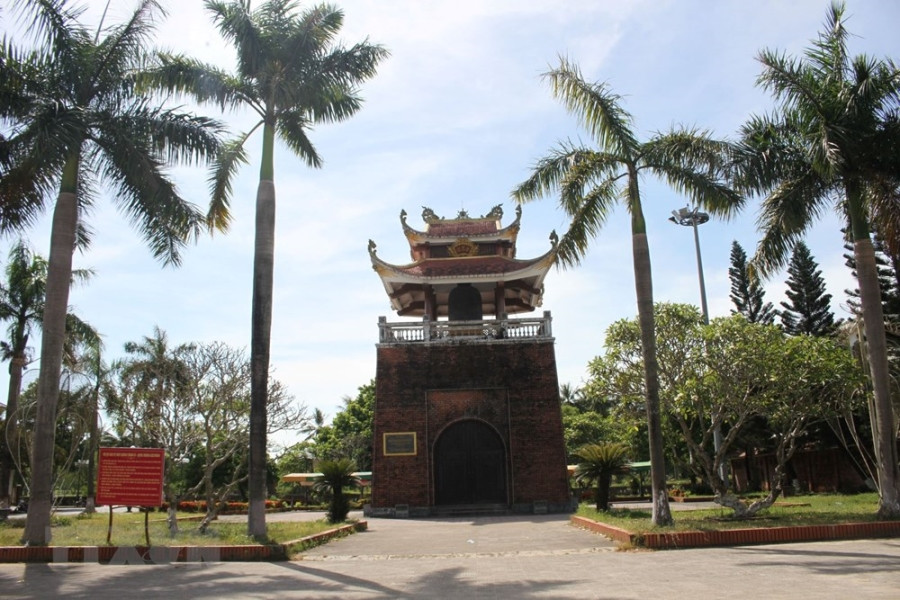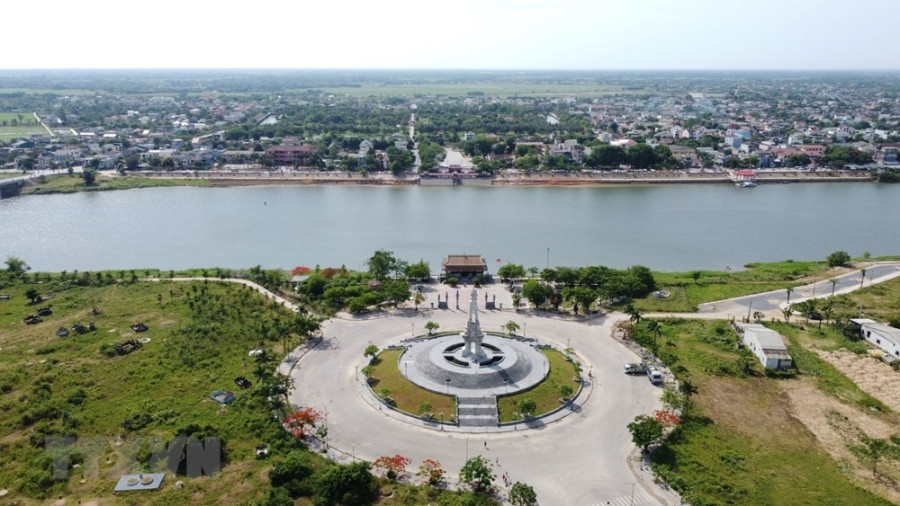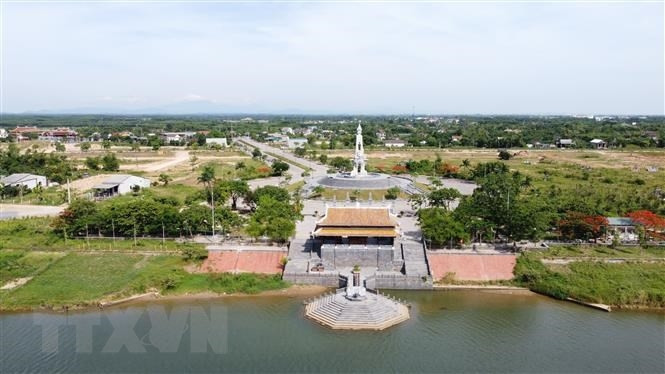50 years have passed, the epic of 81 historical days and nights has faded away, but the land and people of that year in Quang Tri are engraved as a shining symbol of revolutionary heroism.

The Citadel Bell Tower was inaugurated on April 29, 2007 to commemorate the souls of heroes and martyrs who sacrificed their blood for national independence. (Photo: Thanh Thuy/VNA)
The heroic battle during 81 days and nights to protect Quang Tri Citadel (from June 28 to September 16, 1972) has gone down in history as a heroic epic of the army and people of Quang Tri in particular and the whole country in general.
On this extremely fierce battlefield, thousands of the Fatherland's elite sons fell. Their blood and bones were incarnated into every inch of land, merging into the vast waves of the Thach Han River "lulling the immortal song forever"...
"Boat to Thach Han, row gently"
My friend is still there at the bottom of the river.
Twenty years old become waves
"Plain the shore forever"
(Excerpt from the poem "Words of the riverside person" - Le Ba Duong)
Quang Tri Citadel - "81 days and nights of blood and flowers"
Located in the center of Quang Tri town, Quang Tri Citadel is an ancient citadel architecture and also the administrative and political headquarters of Quang Tri province.
Throughout history, as the political, economic and cultural center of the province, Quang Tri Citadel not only played a great role in the development of the locality, but also played a very important role in the development process of the nation.
On December 9, 2013, Quang Tri Citadel was ranked as a Special National Monument by the Prime Minister under Decision No. 2383/QD-TTg.
During the resistance war against American imperialism, the US-puppet government considered the Quang Tri defense line the most solid “dike” in South Vietnam. However, that defense line was breached by our army on May 1, 1972, forcing the enemy to withdraw from Quang Tri town. Quang Tri was the first province in the South to be completely liberated, with a population of more than 100,000.
Not accepting the loss of Quang Tri, with maximum aid from the US empire, the Saigon government mobilized all its forces to launch a counterattack to retake Quang Tri, with the number one goal being to retake the Citadel.
Politically, they hoped that through this counterattack they would regain their morale, erase the defeatist mentality that was spreading throughout the puppet army, and at the same time put pressure on us at the Paris conference.
Militarily, they hoped to defeat our attack, maintain the ancient capital of Hue and retake Quang Tri province - a strategic southern frontier, an important traffic hub connecting Vietnam with Central and Lower Laos. This was also one of the last efforts to save the "Vietnamization of the war" strategy that was going bankrupt.
On June 13, 1972, Nguyen Van Thieu decided to launch the "recapture of Quang Tri" operation codenamed "Lam Son 72". To ensure victory, Nguyen Van Thieu mobilized the four strongest divisions, including the entire airborne division and the marine division of the strategic mobile force.
The forces participating in the campaign were equivalent to 13 infantry regiments, 17 artillery battalions, 5 armored divisions, and many US air force and gunboat units; at the same time, Lieutenant General Ngo Quang Truong - a general with the highest expectations among the generals of the Republic of Vietnam Army - was appointed Commander of Military Region 1, Army Corps 1.
On June 14, 1972, the enemy began the operation “Recapture Quang Tri”. This was the fiercest battle in the history of the Vietnam War - dubbed the “Red Summer”, with unprecedented mobilization of firepower.

Victory Monument on the north bank of Thach Han River. (Photo: Thanh Thuy/VNA)
Opening the "Lam Son 72" operation on the morning of June 28, 1972, under the support of the US Air Force and Navy, the main divisions of the Army of the Republic of Vietnam massively attacked the North bank of the My Chanh River, carrying out the operation to "retake the territory."
The battle between us and the enemy in Quang Tri for 81 days and nights, from June 28 to September 16, 1972, was extremely fierce, day and night. The two sides fought for every meter of land, every house. Bombs and bullets completely destroyed Quang Tri town. The ancient citadel was also completely destroyed.
Important checkpoints such as Long Quang, Tri Buu church, Long Hung intersection, Cau Ga intersection... were places where the liberation army disregarded danger and hardship to crush the enemy's counterattacks. There were days when we had to face 5 attacks by enemy infantry, tanks, and artillery.
In particular, Quang Tri Citadel was the fiercest focal point and also the place that demonstrated the heroic spirit of sacrifice and extraordinary fighting of our army and people. Thousands of soldiers fell in this fierce battle.
On September 16, 1972, our troops proactively withdrew from the Citadel after causing heavy losses to the enemy. We destroyed 2 enemy strategic mobile divisions, killed 26,000 soldiers, captured 71 soldiers, severely damaged 19 battalions, destroyed 349 military vehicles including 200 tanks and armored vehicles, shot down 205 aircraft, and captured 500 guns of various types.
Immortal song
The People's Army newspaper published on August 9, 1972 wrote: "Every square meter of land at Quang Tri Citadel is a meter of blood and your sacrifice has become immortal. During 81 days and nights, from June 28 to September 16, 1972, Quang Tri Citadel had to endure 328,000 tons of bombs and bullets. On average, each soldier had to endure 100 bombs and 200 artillery shells. Every day, a company crossed the Thach Han River to reinforce the troops, but if a company entered tonight, tomorrow there would only be a few survivors."
During those days, our army and people overcame countless difficulties, fierce weather, and continuous rain and floods to hold out and fight the formidable, well-trained Saigon puppet army with unprecedented firepower support in the history of the American imperialists' war of aggression in Indochina.
An American newspaper wrote: How did discipline, idealism and a spirit of contempt for death combine to make the Viet Cong soldiers continue to charge forward under the rain of B52 bombs? No analyst in the United States has come up with a complete explanation.
Later, many military art researchers raised the question: What power made tens of thousands of soldiers, despite the danger of bombs and bullets, willingly cross the river to protect the Citadel without sparing their lives? This was explained by former veterans as patriotism and revolutionary heroism. When patriotism reaches its peak, death is as easy as merging into the flowing water.

Flower release dock on the northern side of Thach Han River. (Photo: Thanh Thuy/VNA)
The battle here took place like a legend and the way of fighting also went beyond the usual conventions: regardless of infantry or engineers, information, medical... all held guns and shot back at the enemy. The heroic 81-day and night battle to protect Quang Tri Citadel ended, marking the resilient strength and strong will of our army and people.
The soldiers of the Citadel, most of them very young, used their courage to fight against iron and steel to carve a towering monument with the aspiration for independence, unity, conscience and human dignity before the fate of the country. It can be said that the 81-day and night battle to defend the Quang Tri Citadel is an epic of Vietnamese revolutionary heroism written in blood, with countless liberation army soldiers falling, many of whom have their bodies forever dissolved into the land, trees and grass...
The 81-day and night battle to protect the Citadel and Quang Tri town contributed to creating a historical turning point that changed the situation of the war, forcing the US imperialists to resume negotiations and sign the Paris Agreement on ending the war in Vietnam, recognizing the independence, unity and territorial integrity of Vietnam; contributing to creating the premise for our army and people to launch the historic Ho Chi Minh Campaign, creating the Great Victory of Spring 1975, fully realizing the sacred wish of beloved President Ho Chi Minh for the North and South to reunite as one, and the unified Vietnam.
50 years have passed, the epic of 81 historical days and nights has faded away, traces of the battle are not many left, the number of living witnesses is gradually decreasing, but the land of that year, the people of that year are forever engraved as a shining symbol of revolutionary heroism.
Today, Quang Tri Citadel is the place to mark the immortal feats of arms of the army and people of Quang Tri in particular and the whole country in general; the place to educate the tradition of patriotism and revolutionary tradition for today and for future generations.
Quang Tri today has risen strongly with a new vitality, writing a true fairy tale about "the land of steel blossoming."
From a land of bombs and bullets, the province's socio-economic appearance is constantly developing, and people's income and living standards are clearly improving.
According to VNA